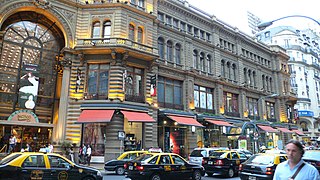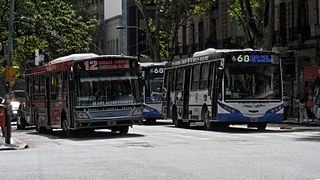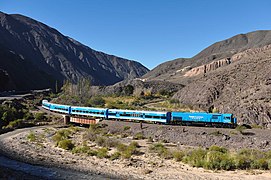Transport in Argentina

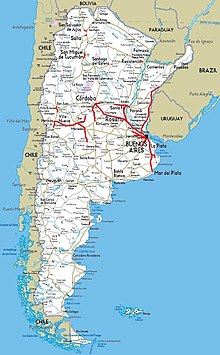
TransportinArgentinais mainly based on a complex network of routes, crossed by relatively inexpensive long-distancebusesand bycargotrucks. The country also has a number of national and internationalairports.The importance of the long-distancetrainis minor today, though in the past it was widely used and is now regaining momentum after there-nationalisationof the country's commuter and freight networks.[1][2]Fluvialtransport is mostly used for cargo.
Within the urban areas, the main transportation system is by the bus orcolectivo;bus lines transport millions of people every day in the larger cities and theirmetropolitan areasas well as abus rapid transportsystem known asMetrobus.Buenos Airesadditionally has anunderground,the only one in the country, andGreater Buenos Airesis serviced by a system ofsuburban trains.
Public transportation
[edit]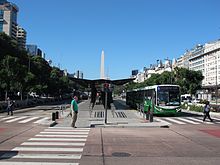
A majority of people usepublic transportrather than personal cars to move around in the cities, especially in common business hours, since parking can be both difficult and expensive[citation needed].Cycling is becoming increasingly common in big cities as a result of a growing network of cycling lanes in cities like Buenos Aires andRosario.[3][4]
Bus
[edit]TheColectivo(urban bus) cover the cities with numerous lines. Fares might be fixed for the whole city, or they might depend on the destination.Colectivosoften cross municipal borders into the corresponding metropolitan areas. In some cases there arediferenciales(special services) which are faster, and notably more expensive. Bus lines in a given city might be run by different private companies and/or by the municipal state, and they might be painted in different colours for easier identification. The city of Buenos Aires has in recent years been expanding itsMetrobusBRT system to complement its existingUndergroundnetwork and it is estimated that, along with other measures, it will increase the city's use of public transport by 30 percent.[5]
Taxi
[edit]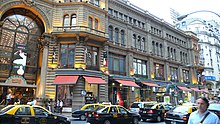
Taxis are very common and relatively accessible price-wise. They have different colours and fares in different cities, though a highly contrasted black-and-yellow design is common to the largest conurbations. Call-taxi companies (radio-taxis) are very common, while theremisseis another form of hired transport: they are very much like call-taxis, but do not share a common design, and trip fares are agreed beforehand instead of using the meter.[6]Although, there are often fixed prices for common destinations.[citation needed]
Commuter rail
[edit]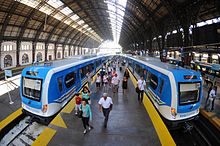
Suburban trainsconnectBuenos Airescity with theGreater Buenos Airesarea,(see:Buenos Aires commuter rail network).Every weekday, more than 1.4 million peoplecommuteto the Argentine capital for work and other business.[7]These suburban trains work between 4 AM and 1 AM. The busiest lines are electric, several are diesel powered, while some of these are currently being electrified, while the rolling stock is being replaced across the city.[8]Until recently,Trenes de Buenos Aires,UGOFE,FerrovíasandMetrovíaswere some of the private companies which provided suburban passenger services in the Buenos Aires metropolitan area. However, with the modernisation and re-nationalisation of these services, many of these companies have had their contracts terminated or have been absorbed intoTrenes Argentinos(the state railway operator), though as of 2015 some private operators such as Metrovías (Urquiza Line) do remain.[9]
Other cities in Argentina with a system of suburban trains includeResistencia,ParanáandMendoza,which is home to theMetrotranvía Mendoza- an urbanlight railnetwork.[10]A commuter rail network forCórdobais planned to complement the existingTren de las Sierraswhich currently runs through the city and to nearby towns and villages.[11]
Underground Subway
[edit]
As of 2015, Buenos Aires is the only Argentine city with an undergroundmetro system,nonetheless there is a project to build a system in the city ofCórdoba(Córdoba Metro) making it the second underground system in Argentina.[12]TheBuenos Aires Underground(Subterráneo de Buenos Aires) has currently six lines, each labelled with a letter from A to H, though 3 more lines are planned.[13][14][15]A modern tram line (PreMetro) line E2 works as a feeder toUnderground Line Eat their outer terminus as well as theUrquiza LineforUnderground Line BinChacarita.Daily ridership is 1.3 million and on the increase. Most of the lines of the Buenos Aires Undergrounds connect the city centre (Micro-centro) with areas in the outskirts of the city proper, though none go outside the city limits toGreater Buenos Aires.
In recent years, the Underground has seen a gradual expansion, with lines H, B and A seeing extensions. As of 2015, the extension of lines E and H are under construction, with work commenced on the new line F and two additional lines (G and I) planned.[16]Similarly, the rolling stock has been gradually replaced in recent years and there are further plans to modernise.[17]
Tram
[edit]
Trams(streetcars), once common, were retired as a form of public transport in the 1960s but are now in the stages of a slow comeback. In 1987 a moderntram linewas opened as a feeder for the underground system. A modernlight railline between the Bartolomé Mitre suburban railway station and Tigre (Tren de la Costa) inaugurated in 1996 operates in the northern suburbs. A 2-kilometre tram known as theTranvía del Este(Eastern Tram) was inaugurated 2007 in thePuerto Maderodistrict of Buenos Aires using loaned FrenchAlstom Citadistrams,[18]but plans for its extension never came to fruition, and declining patronage led the line's closure in 2012.
Trams were once extremely common in Buenos Aires, with the city having a large 875 kmtramway networkand the largest tramway-to-population ratio the world, which gained it notoriety as "the city of trams" across the world.[19][20][21]The first trams began operating in the 1860s, however by the 1960s the network was dismantled and replaced by buses.[22][23]There is aHeritage Tramwaymaintained by enthusiasts that operates a large collection of vintage trams on weekends, near thePrimera JuntaUnderground Line Astation in theCaballitoneighbourhood.[24]
The city ofMendozaalso has its own tram system called theMetrotranvía Mendozawhich has 16 stations and connects the city with its conurbation. Other Argentine cities with tram systems areParanáandLa Plata,both using the nationally builtTecnoTrenrailbuses.The city ofSantiago del Esterois constructing an elevated light rail system to connect itself with its metropolitan area.Trolleybusesare operated inCórdoba,MendozaandRosario.
Road transport
[edit]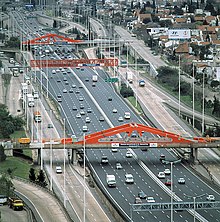
Since Argentina is almost 4,000 kilometres long and more than 1,000 km wide, long distance transportation is of great importance. Several toll expressways spread out fromBuenos Aires,serving nearly half the nation's population. The majority of Argentine roads, however, are two-lane national and provincial routes and, though they are spread throughout the country, less than a third of Argentina's 230,000 km (145,000 mi)[25]of roads are currently paved.
Though, by 1929, Argentina was already home to over 400,000 vehicles,[26][27]virtually all long-distance travel was done on the nation's vast railways. Argentina, then, lacked a road-building program until 1932, when the National Highway Directorate was established. Paid for at first with an excise tax on gasoline, the bureau could claim some important accomplishments, like the 1951 opening of the 200 kmSanta Fe-Rosarioexpressway.
Argentina is home to around 9.2 million registered cars, trucks and buses;[28]on a per capita basis, it has long had Latin America's widest accessibility to motor vehicles.[29]Left-lane drivers until 1945, Argentine motorists have since been driving on the right-hand side. TheVehicle registration plates of Argentinaare based on a three letters-three numbers per car (with the exception of some trucks) system.
Expressways have been recently doubled in length (to nearly)[30]and now link most (though not all) important cities. The most important of these is probably thePanamericanNational Route 9Buenos Aires –Rosario–Córdobafreeway. The longest continuous highways areNational Route 40,a 5000-km stretch along theAndesrange and the 3000-km sea-side trunk roadNational Route 3,running fromBuenos AirestoUshuaia.
Long distance buses
[edit]Argentine long distance buses are fast, affordable and comfortable; they have become the primary means of long-distance travel sincerailway privatisationsin the early 1990s greatly downsized Argentina's passenger rail service and plane tickets are more expensive. Competing providers differ little on their time-honoured formula, offering three different services regarding the number of stops and type of seats: theRegular,Semi-cama(semi-bed), andCama(bed), withCamabeing similar to an airline'sbusiness classbut the names vary. They may also be calledEjecutivo,Cama-vip,Cama-suiteand some other names. Some services, usually the ones that are more expensive, have also on-board dining, while others stop at restaurants by the road. Long and middle-distance buses cover almost all paved-accessible cities, towns and villages.[citation needed]
Rail transport
[edit]Long-distance passenger services
[edit]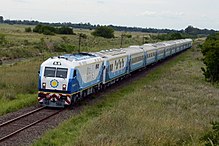
Services on Argentina's passenger railway system, once extensive and prosperous, were greatly reduced in 1993 following the break-up ofFerrocarriles Argentinos(FA), the state railway corporation.[31]Despite the decline of the railway under privatisation, Argentina still maintains the 8th largest rail network in the world, with 36,966 km of track.[32]
Following the break-up, however, severalprivate and provincial railway companieshad been created and resurrected some of the major passenger trains that FA once operated, albeit with far more limited services than under state administration.Trenes de Buenos Aires,Ferrocentral,Ferrobaires,andTren Patagónicowere some of the private companies that managed Argentina's long distance passenger rail network in this period.
More recently, the government has begun nationalising some of these private companies or simply not renewing their contracts, while at the same time, the state-ownedTrenes Argentinosbegan re-opening services and improving on the once private services using completely new rolling stock, including services from Buenos Aires toMar del Plataand Buenos Aires-Rosario-Cordoba.[33][34]In many cases, theArgentine Governmenthas completely replaced, or is in the process of replacing, the existing infrastructure withcontinuous welded railson concrete sleepers.[35][36]
The national government's official stance on rail transport is to re-open all lines that ceased operation following the privatisation in the 1990s.[37]In April 2015, by overwhelming majority theArgentine Senatepassed a law which re-createdFerrocarriles ArgentinosasNuevos Ferrocarriles Argentinos,effectively re-nationalising the country's railways, a move which saw support from all political parties on both sides of the political spectrum.[38][39][40]
High-speed rail
[edit]Ahigh-speed railline between Buenos Aires, Rosario and Córdoba with speeds up to 320 km/h is in the design stages. Construction was supposed to begin by early 2009 for the first segment to Rosario.
In 2007 bids were called for a turnkey contract for a second high speed line, linkingBuenos AiresandMendoza.[41]
In February 2008 national government announced another call for bid, this time for construction of a high speed train linkingBuenos AiresandMar del Plata;The Mar del Plata TAVe.[42][43]As of 2015, the project remains suspended.
Freight service
[edit]
Over 25 million tonnes of freight were transported by rail in 2007.[44]Currently, five carriers operate freight rail services in Argentina:
- Nuevo Central Argentino
- Ferroexpreso Pampeano
- Ferrosur Roca
- América Latina Logística
- Belgrano Cargas(Now owned by the Argentine Government underFerrocarriles Argentinos (2015))
The government began refurbishing and investing heavily in the country's freight network from 2014, beginning with the re-nationalisation of theBelgrano Cargasfreight operator.[45]Further investment of US$2.5 billion has been agreed withChinain an effort to improve freight capacity throughout Argentina and refurbish ageing track segments.[46]Through this investment, the government ordered 1000 freight wagons from Argentine state-owned companyFabricaciones Militares,while the deal with China included the purchase of 100 locomotives and 3,500 carriages from the country.[47][48]This investment was doubled to US$4.8 billion in September 2015.[49]
A map of the existing freight network in Argentina (as of 2014) can be found here[1].
Tourist railways
[edit]
A number ofsteam poweredheritage railways(tourist trains) are in operation;the Old Patagonian Express(locally known as "La Trochita" ) inPatagonia,the Train of the End of the World (Southern Fuegian Railway) inUshuaia,Tierra del Fuego and a short run Tren Histórico deBariloche.
A diesel-electricTren a las Nubesin the province ofSaltaruns from the city ofSaltato San Antonio de los Cobres. The national government had closed the line after nationalising it in order to restore the tracks, however it returned to service in March, 2015 with refurbished rolling stock and rails under the operation ofTrenes Argentinos.[50][51]
TheTren de las Sierras,as well as linking together parts of the centre of the city of Córdoba, also functions as a tourist railway along theSierras de Córdobafoothills.[52][53]
International rail links to adjacent countries
[edit] Bolivia-1,000 mm(3 ft3+3⁄8in) gauge both countries. Two rail connections between (Villazón,Bolivia -La Quiaca,Argentina) and (Yacuiba,Bolivia -Salvador Mazza,Argentina).
Bolivia-1,000 mm(3 ft3+3⁄8in) gauge both countries. Two rail connections between (Villazón,Bolivia -La Quiaca,Argentina) and (Yacuiba,Bolivia -Salvador Mazza,Argentina). Brazil-break of gauge,1,435 mm(4 ft8+1⁄2in) gauge in Argentina and1,000 mm(3 ft3+3⁄8in) gauge in Brazil. Bridge overUruguay RiverlinkingPaso de los Libres(Argentina) andUruguaiana(Brazil).
Brazil-break of gauge,1,435 mm(4 ft8+1⁄2in) gauge in Argentina and1,000 mm(3 ft3+3⁄8in) gauge in Brazil. Bridge overUruguay RiverlinkingPaso de los Libres(Argentina) andUruguaiana(Brazil). Chile-South Trans-Andean Railwaylink betweenZapala,Argentina andLonquimay,Chile.1,676 mm(5 ft 6 in) gauge in both countries.[54]
Chile-South Trans-Andean Railwaylink betweenZapala,Argentina andLonquimay,Chile.1,676 mm(5 ft 6 in) gauge in both countries.[54] Chile-Transandine RailwaybetweenMendozaandSanta Rosa de Los Andes,now defunct, but under reconstruction.[55]Thismountain railwayof1,000 mm(3 ft3+3⁄8in) gauge withrack railwaysections had abreak of gauge5 ft 6 in(1,676 mm)/1,000 mm(3 ft3+3⁄8in) at either end.
Chile-Transandine RailwaybetweenMendozaandSanta Rosa de Los Andes,now defunct, but under reconstruction.[55]Thismountain railwayof1,000 mm(3 ft3+3⁄8in) gauge withrack railwaysections had abreak of gauge5 ft 6 in(1,676 mm)/1,000 mm(3 ft3+3⁄8in) at either end. Chile-Salta–Antofagasta railway,single1,000 mm(3 ft3+3⁄8in) gauge linkingSaltatoAntofagasta.TheTren a las Nubesis a tourist service running for 217 km on the Argentine side.
Chile-Salta–Antofagasta railway,single1,000 mm(3 ft3+3⁄8in) gauge linkingSaltatoAntofagasta.TheTren a las Nubesis a tourist service running for 217 km on the Argentine side. Paraguay-Posadas-Encarnación1,435 mm(4 ft8+1⁄2in) gauge both countries, service began in 2014.
Paraguay-Posadas-Encarnación1,435 mm(4 ft8+1⁄2in) gauge both countries, service began in 2014. Uruguay-Tren de los Pueblos Libres1,435 mm(4 ft8+1⁄2in) in both countries, a short-lived service made to re-open the once closed link. It ceased operation after all concessions to the private companyTBAwere revoked following theOnce Tragedy.
Uruguay-Tren de los Pueblos Libres1,435 mm(4 ft8+1⁄2in) in both countries, a short-lived service made to re-open the once closed link. It ceased operation after all concessions to the private companyTBAwere revoked following theOnce Tragedy.
New International link proposed
[edit]A modern railway connection in order to replace the now-defunctTransandine Railwaybetween Argentina and Chile has been proposed and is currently in the planning stages with support from an international consortium of companies. The rail link will carry both passengers and freight through theAndes,linking the cities of Buenos Aires andSantiago de Chile.The link would also service Argentina's vastoil fields.[56][57]
Air travel
[edit]

Though traditionally more expensive when compared with the other means of transportation,air travelis becoming increasingly common due to more competitive prices. Every provincial capital has its own airport, and there are many others, particularly in tourist areas such asBarilocheandEl Calafate(seelist of airports in Argentina). Most companies have several daily flights to the most popular destinations, and daily or less frequent flights to other destinations. Since 2003, the Ministry of The Interior and Transport has overseen numerous construction works throughout the country's airports, ranging from the building of new terminals to extending the lengths of runways and improving radar systems.[58]
The nationalflag carrierisAerolíneas Argentinas,which was re-nationalised fromIberiain 2008 with the government citing mismanagement under the Spanish firm.[59]Under government ownership, the airline has renewed much of its fleet and tripled its size, with passenger numbers increasing significantly.[60][61]Along with other international carriers, the airline handles most of its international flights fromMinistro Pistarini International Airport.
Even though Buenos Aires is the most importantflight hub,for both economical and geographical reasons, there are flights between important cities, such asCórdoba,RosarioandMendoza.
Argentina had a total of 1,138 airports (including airstrips) in the country in 2013, the 6th highest in the world.[32]
Fluvial transport
[edit]
Fluvialtransport is not often used for people, with the exception of those who cross theRío de la Platafrom Buenos Aires toColonia del SacramentoandMontevideo,both inUruguay.Other services are exclusively used as river crossing, such as those inTigre.
River traffic is mostly made up of cargo, especially on theParaná River,which is navigable by very large ships (Panamaxkind) downstream from theGreater Rosarioarea. This area produces and/or ships most of the agriculturalexportsof Argentina.
Merchant marine
[edit]Portal:Nautical/Fleet/Argentina
Statistics
[edit]- Roadways[62]
- Total: 281,290 km (2017)
- country comparison to the world:21
- Paved: 117,616 km (including 1,575 km of expressways)[30]
- Unpaved: 163,674 km
- 36,917 km (2014)
- country comparison to the world:6
- Passengers annually: 2 billion
- Freight: 26 million metric tons (2008)[63]
- 11,000 km navigable (2012)
- country comparison to the world:11
- Freight: 28 million metric tons[64]
- Crude oil:6,248 km
- Petroleum products:3,631 km
- Natural gas:29,930 km (2013)
- Total (including airstrips): 1,138 (2013)
- country comparison to the world:6
![]() This article incorporatespublic domain materialfromThe World Factbook.CIA.
This article incorporatespublic domain materialfromThe World Factbook.CIA.
Gallery
[edit]-
Various Taxis inBuenos Aires.
-
Passengers on theBuenos Aires Underground
-
Tren a las Nubestourist train
See also
[edit]References
[edit]- ^Se instruye a la sociedad Operadora Ferroviaria Sociedad del Estado para que instrumente las medidas necesarias a los efectos de rescindir los Acuerdos de OperaciónCrónica FerroviariaMarch, 2015
- ^"El ferrocarril de carga debe ser el eje del transporte en Argentina"Crónica FerroviariaMarch, 2015
- ^El sistema más humano de bicicletas compartidas está en Buenos AiresWorld Bank,July 2013.
- ^Cambiá el aire! Calle RecreativaMunicipalidad de Rosario
- ^Metrobus South opens, 23km added to City bus networkBuenos Aires Herald,August 2014.
- ^"Argentina-Buenos-Aires-getting-around-taxis-buses-trains-public-transport".travel-tourist-information-guide.Archived fromthe originalon 2018-08-21.Retrieved2015-10-11.
- ^Detalles del proyecto para conectar todos los ferrocarriles urbanos debajo del ObeliscoArchived2015-06-12 at theWayback Machine- Buenos Aires Ciudad, 12 May 2015.
- ^Red ferroviaria argentina se moderniza con trenes chinosArchived2015-04-02 at theWayback MachineCCTV,November 2014
- ^Se instruye a la sociedad Operadora Ferroviaria Sociedad del Estado para que instrumente las medidas necesarias a los efectos de rescindir los Acuerdos de OperaciónCrónica Ferroviaria,March 2015
- ^"Tren local Paraná - Oro Verde - Cnia. Avellaneda::: SATELITE FERROVIARIO".sateliteferroviario.ar.Archived fromthe originalon 2018-09-17.Retrieved2015-03-17.
- ^Buscan reflotar el proyecto de tren urbano en la ciudad de CórdobaImpulso,July 2013.
- ^"El municipio empieza a estudiar la factibilidad de un subte en Córdoba"[The municipality begins to study the feasibility of a subway in Cordoba].LaVoz.ar(in Spanish). 15 December 2007. Archived fromthe originalon 29 June 2012.Retrieved2014-04-26.
- ^Confirman proyecto para desviar la línea F a Facultad de Derecho- EnElSubte, 25 November 2014.
- ^Cancelaron las negociaciones con los chinos por la línea GArchived2015-05-18 at theWayback Machine- 24 January 2012
- ^Bodart: El Metrobús como reemplazo de la línea I es "una estafa transversal"- EnElSubte, 16 April 2015.
- ^Plan de ExpansionArchived2015-05-02 at theWayback MachineBuenos Aires Ciudad
- ^Plan De Material RodanteArchived2015-05-04 at theWayback MachineBuenos Aires Ciudad
- ^Francia quiere una red de tranvías en Buenos AiresArchived2015-04-16 at theWayback Machine- La Nacion, 18 January 2008.
- ^Trams Of ArgentinaArchived2015-12-08 at theWayback Machine- Don Ross Group, 7 November 2014.
- ^Historia del tranvía en Buenos AiresArchived2015-04-10 atarchive.today- Revista Digital ead
- ^Un viaje por la historia de la ciudad en el viejo Tramway- ElDiario.es, 21 March 2015.
- ^Leyland Urbanos en los '60.- BusARG
- ^APUNTES SOBRE LA HISTORIA DEL TRANVÍA EN BUENOS AIRESArchived2013-07-28 at theWayback Machine- Biblioteca Popular Federico Lacroze
- ^La AAT celebra con un festival los 150 años del tranvíaArchived2015-05-18 at theWayback Machine- EnElSubte, 12 July 2013
- ^"ADEFA"(PDF).adefa.ar.[permanent dead link]
- ^"Coche Argentino - Cronología".cocheargentino.ar.Archived fromthe originalon 2008-10-29.
- ^The World Almanac (1929), p.327.
- ^"DNRPA".gov.ar.Archived fromthe originalon 2009-01-24.
- ^Encyclopædia Britannica Book of the Year, Statistical Appendix; various editions since 1948.
- ^abhttp:// grupopayne.ar/archivo/01/0112/011211/institucionales/institucionales[permanent dead link].html
- ^Argentina sets a new courseArchived2007-10-23 at theWayback Machine.Railway Gazette InternationalAugust 2007.
- ^ab"CIA World Factbook - Argentina".cia.gov.Retrieved2015-03-18.
- ^Salgado, Carlos Alberto (10 March 2015)."CRÓNICA FERROVIARIA: Randazzo:" Estamos saldando una deuda con las ciudades del interior del país "".wwwcronicaferroviaria.blogspot.ar.
- ^Exitosa prueba en la renovada vía a RosarioEnElSubte,March 2015
- ^Salgado, Carlos Alberto (11 March 2015)."CRÓNICA FERROVIARIA: En tren, de Buenos Aires a Córdoba a 36 kilómetros por hora".wwwcronicaferroviaria.blogspot.ar.
- ^Rescinden contratos a privados y vuelve Ferrocarriles ArgentinosEnElSubte,March 2015
- ^Randazzo arribó en el tren 0km que unió por primera vez Buenos Aires con Rosario y confirmó que "el 1 de abril comenzará a prestar servicio regular"Archived2015-03-15 at theWayback MachineMinisterio del Interior y Transporte,March 2015
- ^Otro salto en la recuperación de soberanía- Pagina/12, 16 April 2015
- ^Es ley la creación de Ferrocarriles Argentinos- EnElSubte, 15 April 2015
- ^Ferrocarriles Argentinos: Randazzo agradeció a la oposición parlamentaria por acompañar en su recuperaciónArchived2015-04-16 at theWayback Machine- Sala de Prensa de la Republica Argentina, 15 April 2015
- ^"Mendoza bids".Railway Gazette International.2007-08-23. Archived fromthe originalon 2008-03-17.Retrieved2008-01-21.
- ^"Bullet train for Mar del plata".2008-08-02. Archived fromthe originalon 2008-02-11.Retrieved2008-02-15.
- ^IRJ,September 2007, p524
- ^http:// mecon.gov.ar/actividad_ied.xls[permanent dead link]
- ^Salgado, Carlos Alberto (11 May 2014)."CRÓNICA FERROVIARIA: Recuperación del Belgrano Cargas y Logística S.A."wwwcronicaferroviaria.blogspot.
- ^China invertirá u$s 2.470 millones en el FFCC Belgrano CargasArchived2015-04-02 at theWayback MachineCronica del NOA
- ^Fabricaciones Militares construirá más de 1000 vagones para el Belgrano CargasArchived2015-05-09 at theWayback Machine- Fabricaciones Militares
- ^Avanza la renovación del Belgrano Cargas con financiamiento chino- Telam, 14 February 2015.
- ^Duplicarán el crédito chino para cargas: invertirán más de 4800 millones de USD- EnElSubte, 14 September 2015.
- ^"El tren más famoso del país vuelve a las nubes",Perfil,1 Apr 2015
- ^Después de ocho meses, volvió el Tren a las NubesArchived2016-01-23 at theWayback Machine- La Nacion, 05 April 2015
- ^"Se reactivó el Tren de las Sierras desde Alta Córdoba"Archived2015-07-17 at theWayback Machine,La Mañana,17 Mar 2015
- ^"Randazzo recibió el tren que vuelve a unir Alta Córdoba con Cosquín"Archived2015-05-05 at theWayback Machine,Ministerio del Interior y Trasporte,17 Mar, 2015
- ^"Initiative for Regional Infrastructure Integration in South America"(PDF).iadb.org.Archived fromthe original(PDF)on 2007-06-28.
- ^En julio se licitará tren Los Andes - MendozaArchived2007-03-10 at theWayback MachineRetrieved on 26 May 2008 (Spanish)
- ^Corredor Bioceánico: proyecto que unirá puertos del Atlántico y PacíficoDiarioUChile,May 2014
- ^Tren Trasandino: Las vías que quieren despertarArchived2018-02-01 at theWayback MachineMDZ Online,May 2014
- ^Obras Realizadas desde el 2003 hasta la actualidadArchived2015-04-02 at theWayback MachineORSNA
- ^Argentina renationalises airline,December 2008
- ^"Informe Aerolíneas Argentinas"(PDF).Archived fromthe original(PDF)on 2014-08-07.Retrieved2015-03-17.
- ^Cristina Kirchner presentó un nuevo avión de Aerolíneas junto a Scioli, Randazzo y RecaldeArchived2015-03-13 at theWayback MachineLa Nacion, March 2015
- ^abThe World Factbook
- ^"INDEC: servicios publicos"(PDF).mecon.ar.Archived fromthe original(PDF)on 2009-02-26.Retrieved2009-01-17.
- ^Encyclopædia Britannica Book of the Year:World Data, Transport. Encyclopædia Britannica, Inc. 2005.

